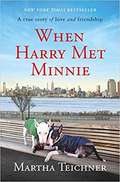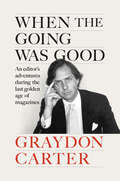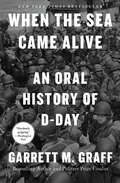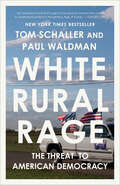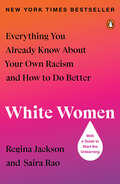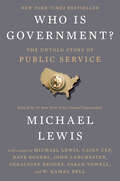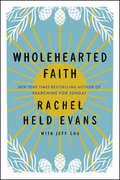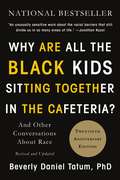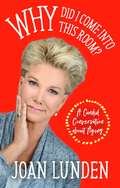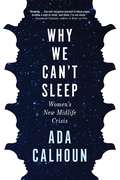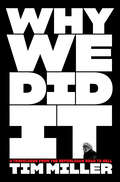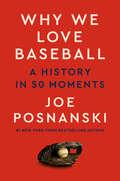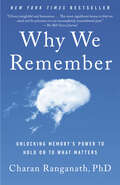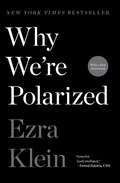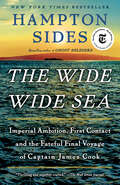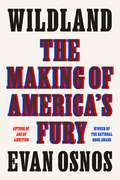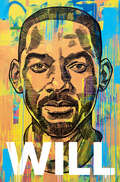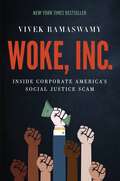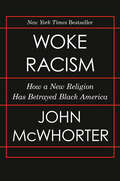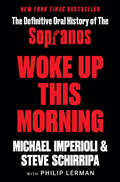Special Collections
New York Times Best Sellers - Non-Fiction
Description: Bookshare is pleased to offer the top 10 non-fiction books from the New York Times best seller list on a weekly basis. Books are added in as they become available. The month corresponds to the first time they appeared on the list. #adults
- Table View
- List View
When Harry Met Minnie
by Martha TeichnerA memoir of love and loss, of being in the right place at the right time, and of the mysterious ways a beloved pet can bring people together, from CBS Sunday Morning News correspondent and multi-Emmy-Award-winning Martha Teichner.
There are true fairy tales. Stories that exist because impossible-to-explain coincidences change everything. Except in real life, not all of them have conventional, happily-ever-after endings. When Harry Met Minnie is that kind of fairy tale, with the vibrant, romantic New York City backdrop of its namesake, the movie When Harry Met Sally, and the bittersweet wisdom of Tuesdays with Morrie.
When the Going Was Good
by Graydon CarterAn Instant New York Times BestsellerFrom the pages of Vanity Fair to the red carpets of Hollywood, editor Graydon Carter&’s memoir revives the glamorous heyday of print magazines when they were at the vanguard of American cultureWhen Graydon Carter was offered the editorship of Vanity Fair in 1992, he knew he faced an uphill battle—how to make the esteemed and long-established magazine his own. Not only was he confronted with a staff that he perceived to be loyal to the previous regime, but he arrived only a few years after launching Spy magazine, which gloried in skewering the celebrated and powerful—the very people Vanity Fair venerated. With curiosity, fearlessness, and a love of recent history and glamour that would come to define his storied career in magazines, Carter succeeded in endearing himself to his editors, contributors, and readers, as well as as well as those who would grace the pages of Vanity Fair. He went on to run the magazine with overwhelming success for the next two and a half decades.Filled with colorful memories and intimate details, When the Going Was Good is Graydon Carter&’s lively recounting of how he made his mark as one of the most talented editors in the business. Moving to New York from Canada, he worked at Time, Life, The New York Observer, and Spy, before catching the eye of Condé Nast chairman Si Newhouse, who pulled him in to run Vanity Fair. In Newhouse he found an unwavering champion, a loyal proprietor who gave Carter the editorial and financial freedom to thrive. Annie Leibovitz&’s photographs would come to define the look of the magazine, as would the &“New Establishment&” and annual Hollywood issues. Carter further planted a flag in Los Angeles with the legendary Vanity Fair Oscar party.With his inimitable voice and signature quip, he brings readers to lunches and dinners with the great and good of America, Britain, and Europe. He assembled one of the most formidable stables of writers and photographers under one roof, and here he re-creates in real time the steps he took to ensure Vanity Fair cemented its place as the epicenter of art, culture, business, and politics, even as digital media took hold. Charming, candid, and brimming with stories, When the Going Was Good perfectly captures the last golden age of print magazines from the inside out.
When the Sea Came Alive
by Garrett M. GraffA NEW YORK TIMES BESTSELLER • &“Absolutely gripping.&” —The Washington Post • &“A masterpiece of oral history…stirring, surprising, grim, joyous, moving, and always riveting.&” —Evan Thomas From the New York Times bestselling author of The Only Plane in the Sky and Pulitzer Prize finalist for Watergate comes the most complete and up-to-date account of D-Day—the largest seaborne invasion in history and the moment that secured the Allied victory in World War II—featuring hundreds of eyewitness accounts.June 6, 1944—known to us all as D-Day—is one of history&’s greatest and most unbelievable military triumphs. The surprise sunrise landing of more than 150,000 Allied troops on the beaches of occupied northern France is one of the most consequential days of the 20th century. Now, Pulitzer Prize finalist Garrett M. Graff, historian and author of The Only Plane in the Sky and Watergate, brings them all together in a one-of-a-kind, bestselling oral history that explores this seminal event in vivid, heart-pounding detail. The story begins in the opening months of the 1940s, as the Germany army tightens its grip across Europe, seizing control of entire nations. The United States, who has resolved to remain neutral, is forced to enter the conflict after an unexpected attack by the Japanese at Pearl Harbor. For the second time in fifty years, the world is at war, with the stakes higher than they&’ve ever been before. Then in 1943, Allied leaders Franklin D. Roosevelt and Winston Churchill meet in Casablanca to discuss a new plan for victory: a coordinated invasion of occupied France, led by General Dwight D. Eisenhower. Failure is not an option. Over the next eighteen months, the large-scale action is organized, mobilizing soldiers across Europe by land, sea, and sky. And when the day comes, it is unlike anything the world has ever seen. These moments and more are seen in real time. A visceral, page-turning drama told through the eyes of those who experienced them—from soldiers, nurses, pilots, children, neighbors, sailors, politicians, volunteers, photographers, reporters and so many more, When the Sea Came Alive &“is the sort of book that is smart, inspiring, and powerful—and adds so much to our knowledge of what that day was like and its historic importance forever&” (Chris Bohjalian)—an unforgettable, fitting tribute to the men and women of the Greatest Generation.
When Women Ran Fifth Avenue
by Julie SatowNEW YORK TIMES BESTSELLER • A glittering portrait of the golden age of American department stores and of three visionary women who led them, from the award-winning author of The Plaza.A BEST BOOK OF THE YEAR: Vogue, Smithsonian, New York Post, and Financial Times"Ms. Satow&’s carefully researched book is compulsively readable: I found myself dashing through it like a novel. She portrays the women with verve; we get a glimpse into their lives, as well as a sense of what it was like at each of these retail meccas." —The Wall Street JournalThe twentieth century American department store: a palace of consumption where every wish could be met under one roof – afternoon tea, a stroll through the latest fashions, a wedding (or funeral) planned. It was a place where women, shopper and shopgirl alike, could stake out a newfound independence. Whether in New York or Chicago or on Main Street, USA, men owned the buildings, but inside, women ruled.In this hothouse atmosphere, three women rose to the top. In the 1930s, Hortense Odlum of Bonwit Teller came to her husband's department store as a housewife tasked with attracting more shoppers like herself, and wound up running the company. Dorothy Shaver of Lord & Taylor championed American designers during World War II--before which US fashions were almost exclusively Parisian copies--becoming the first businesswoman to earn a $1 million salary. And in the 1960s Geraldine Stutz of Henri Bendel re-invented the look of the modern department store. With a preternatural sense for trends, she inspired a devoted following of ultra-chic shoppers as well as decades of copycats.In When Women Ran Fifth Avenue, journalist Julie Satow draws back the curtain on three visionaries who took great risks, forging new paths for the women who followed in their footsteps. This stylish account, rich with personal drama and trade secrets, captures the department store in all its glitz, decadence, and fun, and showcases the women who made that beautifully curated world go round.
Where Law Ends
by Andrew WeissmannIn May 2017, Robert Mueller was tapped to lead an inquiry into Russian interference in the 2016 presidential election, coordination by foreign agents with Donald Trump’s campaign, and obstruction of justice by the president. Mueller assembled a “dream team” of top prosecutors, and for the next twenty-two months, the investigation was a black box and the subject of endless anticipation and speculation—until April 2019, when the special counsel’s report was released.
In Where Law Ends, legendary prosecutor Andrew Weissmann—a key player in the Special Counsel’s Office—finally pulls back the curtain to reveal exactly what went on inside the investigation, including the heated debates, painful deliberations, and mistakes of the team—not to mention the external efforts by the president and Attorney General William Barr to manipulate the investigation to their political ends.
Weissmann puts the reader in the room as Mueller’s team made their most consequential decisions, such as whether to subpoena the president, whether to conduct a full financial investigation of Trump, and whether to explicitly recommend obstruction charges against him. Weissmann also details for the first time the debilitating effects that President Trump himself had on the investigation, through his dangling of pardons and his constant threats to shut down the inquiry and fire Mueller, which left the team racing against the clock and essentially fighting with one hand tied behind their backs.
In Where Law Ends, Weissmann conjures the camaraderie and esprit de corps of the investigative units led by the enigmatic Mueller, a distinguished public servant who is revealed here, in a way we have never seen him before, as a manager, a colleague, and a very human presence. Weissmann is as candid about the team’s mistakes as he is about its successes, and is committed to accurately documenting the historic investigation for future generations to assess and learn from. Ultimately, Where Law Ends is a story about a team of public servants, dedicated to the rule of law, tasked with investigating a president who did everything he could to stand in their way.
Where Tomorrows Aren't Promised
by Carmelo AnthonyFrom iconic NBA All-Star Carmelo Anthony comes a raw and inspirational memoir about growing up in the housing projects of Red Hook and Baltimore—a brutal world Where Tomorrows Aren’t Promised. For a long time, Carmelo Anthony’s world wasn’t any larger than the view of the hoopers and hustlers he watched from the side window of his family’s first-floor project apartment in Red Hook, Brooklyn. He couldn’t dream any bigger than emulating his older brothers and cousin, much less going on to become a basketball champion on the world stage.
He faced palpable dangers growing up in the housing projects in Red Hook and West Baltimore’s Murphy Homes (a.k.a. Murder Homes, subject of HBO’s The Wire). He navigated an education system that ignored, exploited, or ostracized him. He suffered the untimely deaths of his closely held loved ones. He struggled to survive physically and emotionally. But with the strength of family and the guidance of key mentors on the streets and on the court, he pushed past lethal odds to endure and thrive.
By the time Carmelo found himself at the NBA Draft at Madison Square Garden in 2003 preparing to embark on his legendary career, he wondered: How did a kid who&’d had so many hopes, dreams, and expectations beaten out of him by a world of violence, poverty, and racism make it here at all? Carmelo’s story is one of perseverance and determination; of dribbling past players bigger and tougher than him, while also weaving around vial caps and needles strewn across the court; where dealers and junkies lined one side of the asphalt and kids playing jacks and Double Dutch lined the other; where rims had no nets, and you better not call a foul—a place Where Tomorrows Aren’t Promised.
A New York Times Best Seller
White Rural Rage
by Paul Waldman and Tom SchallerNEW YORK TIMES BESTSELLER • A searing portrait and damning takedown of America&’s proudest citizens—who are also the least likely to defend its core principles&“This is an important book that ought to be read by anyone who wants to understand politics in the perilous Age of Trump.&”—David Corn, New York Times bestselling author of American PsychosisWhite rural voters hold the greatest electoral sway of any demographic group in the United States, yet rural communities suffer from poor healthcare access, failing infrastructure, and severe manufacturing and farming job losses. Rural voters believe our nation has betrayed them, and to some degree, they&’re right. In White Rural Rage, Tom Schaller and Paul Waldman explore why rural Whites have failed to reap the benefits from their outsize political power and why, as a result, they are the most likely group to abandon democratic norms and traditions. Their rage—stoked daily by Republican politicians and the conservative media—now poses an existential threat to the United States.Schaller and Waldman show how vulnerable U.S. democracy has become to rural Whites who, despite legitimate grievances, are increasingly inclined to hold racist and xenophobic beliefs, to believe in conspiracy theories, to accept violence as a legitimate course of political action, and to exhibit antidemocratic tendencies. Rural White Americans&’ attitude might best be described as &“I love my country, but not our country,&” Schaller and Waldman argue. This phenomenon is the patriot paradox of rural America: The citizens who take such pride in their patriotism are also the least likely to defend core American principles. And by stoking rural Whites&’ anger rather than addressing the hard problems they face, conservative politicians and talking heads create a feedback loop of resentments that are undermining American democracy.Schaller and Waldman provocatively critique both the structures that permit rural Whites&’ disproportionate influence over American governance and the prospects for creating a pluralist, inclusive democracy that delivers policy solutions that benefit rural communities. They conclude with a political reimagining that offers a better future for both rural people and the rest of America.
White Women
by Saira Rao and Regina JacksonA no-holds-barred guidebook aimed at white women who want to stop being nice and start dismantling white supremacy.It's no secret that white women are conditioned to be "nice," but did you know that the desire to be perfect and to avoid conflict at all costs are characteristics of white supremacy culture? As the founders of Race2Dinner, an organization which facilitates conversations between white women about racism and white supremacy, Regina Jackson and Saira Rao have noticed white women's tendency to maintain a veneer of niceness, and strive for perfection, even at the expense of anti-racism work.In this book, Jackson and Rao pose these urgent questions: how has being "nice" helped Black women, Indigenous women and other women of color? How has being "nice" helped you in your quest to end sexism? Has being "nice" earned you economic parity with white men? Beginning with freeing white women from this oppressive need to be nice, they deconstruct and analyze nine aspects of traditional white woman behavior--from tone-policing to weaponizing tears--that uphold white supremacy society, and hurt all of us who are trying to live a freer, more equitable life.White Women is a call to action to those of you who are looking to take the next steps in dismantling white supremacy. Your white supremacy. If you are in fact doing real anti-racism work, you will find few reasons to be nice, as other white people want to limit your membership in the club. If you are not ticking white people off on a regular basis, you are not doing it right.
Who Could Ever Love You
by Mary L. TrumpMary Trump grew up in a family divided by its patriarch’s relentless drive for money and power. The daughter of Freddy Trump, the highly accomplished, dashing eldest son of wealthy real estate developer Fred Trump, and Linda Clapp, a flight attendant from a working-class family, Mary lived in the shadow of Freddy’s humiliation at the hands of his father.
Fred Trump embodied the ethos of the zero-sum game and among his five children, there could only be one winner. That was supposed to be Freddy, his namesake, but Fred found him wanting—too sensitive, too kind, too interested in pursuits beyond the realm of the real estate empire he was meant to inherit. In Donald, Fred found a kindred spirit, a “killer,” who would stop at nothing to get his own way.
Even after Freddy’s short-lived career as a professional pilot for TWA came to an end, he never stopped trying to gain his father’s approval. Finally, at the age of forty-two, he succumbed to Fred’s lethal contempt and died alone in an emergency room, with no family by his side.
In WHO COULD EVER LOVE YOU, Mary Trump brings us inside the twisted family whose patriarch ignored, froze out, and eventually destroyed his own. Freddy Trump’s decline into alcoholism and illness, along with Linda’s suffering after their divorce, left Mary dangerously vulnerable as a very young girl.
Inadequately and only conditionally loved, there were no adults in her life except for the father she loved, but lost before she could know him; and a mother abandoned by her ex-husband’s rich and powerful family who demanded her loyalty but left her with nothing.
With searching insight, poignant detail, and unsparing prose, Mary Trump reveals the cold, selfish cruelty that has come to define the Trump family thanks in large part to her uncle, whose malignant ambition has riven our nation and threatens the world.
New York Times Bestseller
Who Is Government?
by Edited by Michael Lewis“Michael Lewis has this incredible ability to zoom in on one person's story, and from there reveals something much bigger about our culture. His books leave you seeing the world differently, and his books about federal workers are no exception.” – Katie Couric.
Who works for the government and why does their work matter? An urgent and absorbing civics lesson from an all-star team of writers and storytellers. The government is a vast, complex system that Americans pay for, rebel against, rely upon, dismiss, and celebrate. It’s also our shared resource for addressing the biggest problems of society. And it’s made up of people, mostly unrecognized and uncelebrated, doing work that can be deeply consequential and beneficial to everyone.
Michael Lewis invited his favorite writers, including Casey Cep, Dave Eggers, John Lanchester, Geraldine Brooks, Sarah Vowell, and W. Kamau Bell, to join him in finding someone doing an interesting job for the government and writing about them. The stories they found are unexpected, riveting, and inspiring, including a former coal miner devoted to making mine roofs less likely to collapse, saving thousands of lives; an IRS agent straight out of a crime thriller; and the manager who made the National Cemetery Administration the best-run organization, public or private, in the entire country.
Each essay shines a spotlight on the essential behind-the-scenes work of exemplary federal employees. Whether they’re digitizing archives, chasing down cybercriminals, or discovering new planets, these public servants are committed to their work and universally reluctant to take credit. Expanding on the Washington Post series, the vivid profiles in Who Is Government? blow up the stereotype of the irrelevant bureaucrat. They show how the essential business of government makes our lives possible, and how much it matters. New York Times Bestseller
Wholehearted Faith
by Jeff Chu and Rachel Held Evans“A touching series of essays in which Held Evans, with Chu’s invisible pen, explores how one might find a path forward in Christianity beyond conservative evangelicalism” -Eliza Griswold, The New Yorker“
Evans died at 37, but a beautiful new book captures her brave outlook. . . . I could not help but notice the poetry in Evans’s prose. . . . What readers will find in these pages was someone deeply human: funny, irreverent, curious, wise, forgiving, nonjudgmental.” -The Washington PostA new collection of original writings by Rachel Held Evans, whose reflections on faith and life continue to encourage, challenge, and influence. Rachel Held Evans is widely recognized for her theologically astute, profoundly honest, and beautifully personal books, which have guided, instructed, edified, and shaped Christians as they seek to live out a just and loving faith.
At the time of her tragic death in 2019, Rachel was working on a new book about wholeheartedness. With the help of her close friend and author Jeff Chu, that work-in-progress has been woven together with some of her other unpublished writings into a rich collection of essays that ask candid questions about the stories we’ve been told—and the stories we tell—about our faith, our selves, and our world.
This book is for the doubter and the dreamer, the seeker and the sojourner, those who long for a sense of spiritual wholeness as well as those who have been hurt by the Church but can’t seem to let go of the story of Jesus. Through theological reflection and personal recollection, Rachel wrestles with God’s grace and love, looks unsparingly at what the Church is and does, and explores universal human questions about becoming and belonging. An unforgettable, moving, and intimate book.
A New York Times Best Seller
Why Are All the Black Kids Sitting Together in the Cafeteria?
by Beverly TatumWalk into any racially mixed high school and you will see black youth seated together in the cafeteria. Of course, it's not just the black kids sitting together-the white, Latino, Asian Pacific, and, in some regions, American Indian youth are clustered in their own groups, too.
The same phenomenon can be observed in college dining halls, faculty lounges, and corporate cafeterias. What is going on here? Is this self-segregation a problem we should try to fix, or a coping strategy we should support? How can we get past our reluctance to talk about racial issues to even discuss it? And what about all the other questions we and our children have about race?
Beverly Daniel Tatum, a renowned authority on the psychology of racism, asserts that we do not know how to talk about our racial differences: Whites are afraid of using the wrong words and being perceived as "racist" while parents of color are afraid of exposing their children to painful racial realities too soon.
Using real-life examples and the latest research, Tatum presents strong evidence that straight talk about our racial identities-whatever they may be-is essential if we are serious about facilitating communication across racial and ethnic divides. We have waited far too long to begin our conversations about race. This remarkable book, infused with great wisdom and humanity, has already helped hundreds of thousands of readers figure out where to start.
A New York Times Bestseller
Why Did I Come into This Room?
by Joan LundenIn her most candid and revealing book yet, acclaimed broadcast journalist and Baby Boomer Joan Lunden delves into the various phases of aging that leave many feeling uncomfortable, confused, and on edge. In her hilarious book, Lunden takes the dull and depressing out of aging, replacing it with wit and humor. After all, laughing is better than crying—unless it makes you pee!
Whether you’re in your 40s, 50s, 60s, or more, this book is full of helpful information to embrace—or at least prepare for—the inevitable. Funny, captivating, and raw, no topic is off limits. Lunden goes where others fear to tread, openly talking about wrinkles and age spots (which Lunden insists are sunspots), expanding waistlines (no, you didn’t shrink your jeans), diminished energy (my get-up-and-go got up and went), weak pelvic floors (yes, we’re talking about leaking), hot flashes (they suck), disrupted sleep (the morning host is an expert on lack of sleep), changes in sex drive (oh yeah, she goes there), ageism (it exists and it pisses us off), and yes, the real reasons we suddenly find ourselves always searching for those car keys!
Through her poignant and often laugh out loud funny personal experiences, Lunden candidly shares her anxieties and breakthroughs and how she’s coping with the realities of aging. She’s talking about the good, the bad and the ugly, elevating the conversation on topics often considered “taboo.”
Why Did I Come into This Room? also explores the science of aging, including how it impacts the body and brain, while dispelling myths and revealing useful options to stave off the aging process as long as possible. Even more importantly, Lunden goes beyond the physical aspects of aging by closely examining the mental and emotional minefields that come with our advancing years. As she explores the value of asking ourselves important questions including, “Am I still relevant?”, “Do I have meaningful friendships?”, and “Am I leaving an impactful legacy?” Lunden also examines the freedom in “letting go,” the importance of managing stress, and how joy and a sense of purpose all play an impactful role in slowing the aging process.
In a society where youth is revered and aging feared, Why Did I Come into This Room? is the long-awaited tell-it-like-it-is guide for women of all ages. As Lunden says, “Aging ain&’t for sissies…you better be prepared.”
A New York Times Bestseller
Why We Can't Sleep
by Ada CalhounWhen Ada Calhoun found herself in the throes of a midlife crisis, she thought that she had no right to complain. She was married with children and a good career. So why did she feel miserable? And why did it seem that other Generation X women were miserable, too? Calhoun decided to find some answers. She looked into housing costs, HR trends, credit card debt averages, and divorce data. At every turn, she saw a pattern: sandwiched between the Boomers and the Millennials, Gen X women were facing new problems as they entered middle age, problems that were being largely overlooked. Speaking with women across America about their experiences as the generation raised to "have it all," Calhoun found that most were exhausted, terrified about money, under-employed, and overwhelmed. Instead of being heard, they were told instead to lean in, take "me-time," or make a chore chart to get their lives and homes in order. In Why We Can't Sleep, Calhoun opens up the cultural and political contexts of Gen X's predicament and offers solutions for how to pull oneself out of the abyss--and keep the next generation of women from falling in. The result is reassuring, empowering, and essential reading for all middle-aged women, and anyone who hopes to understand them.
Why We Did It
by Tim MillerFormer Republican political operative Tim Miller answers the question no one else has fully grappled with: Why did normal people go along with the worst of Trumpism?
As one of the strategists behind the famous 2012 RNC “autopsy,” Miller conducts his own forensic study on the pungent carcass of the party he used to love, cutting into all the hubris, ambition, idiocy, desperation, and self-deception for everyone to see.
In a bracingly honest reflection on both his own past work for the Republican Party and the contortions of his former peers in the GOP establishment, Miller draws a straight line between the actions of the 2000s GOP to the Republican political class's Trumpian takeover, including the horrors of January 6th. From ruminations on the mental jujitsu that allowed him as a gay man to justify becoming a hitman for homophobes, to astonishingly raw interviews with former colleagues who jumped on the Trump Train, Miller diagrams the flattering and delusional stories GOP operatives tell themselves so they can sleep at night. With a humorous touch he reveals Reince Priebus' neediness, Sean Spicer's desperation, Elise Stefanik and Chris Christie’s raw ambition, and his close friends’ submission to a MAGA psychosis.
Why We Did It is a vital, darkly satirical warning that all the narcissistic justifications that got us to this place still thrive within the Republican party, which means they will continue to make the same mistakes and political calculations that got us here, with disastrous consequences for the nation.
New York Times Bestseller
Why We Love Baseball
by Joe PosnanskiNEW YORK TIMES bestsellerWinner of the CASEY Award for Best Baseball Book of the YearNational Sports Media Association Sports Book of the Year An NPR "Book of the Day"#1 New York Times bestselling author Joe Posnanski is back with a masterful ode to the game: a countdown of 50 of the most memorable moments in baseball&’s history, to make you fall in love with the sport all over again. Posnanski writes of major moments that created legends, and of forgotten moments almost lost to time. It's Willie Mays&’s catch, Babe Ruth&’s called shot, and Kirk Gibson&’s limping home run; the slickest steals; the biggest bombs; and the most triumphant no-hitters. But these are also moments raw with the humanity of the game, the unheralded heroes, the mesmerizing mistakes drenched in pine tar, and every story, from the immortal to the obscure, is told from a unique perspective. Whether of a real fan who witnessed it, or the pitcher who gave up the home run, the umpire, the coach, the opposing player—these are fresh takes on moments so powerful they almost feel like myth. Posnanski&’s previous book, The Baseball 100, portrayed the heroes and pioneers of the sport, and now, with his trademark wit, encyclopedic knowledge, and acute observations, he gets at the real heart of the game. From nineteenth-century pitchers&’ duels to breaking the sport&’s color line in the &’40s, all the way to the greatest trick play of the last decade and the slide home that became a meme, Posnanski&’s illuminating take allows us to rediscover the sport we love—and thought we knew. Why We Love Baseball is an epic that ends too soon, a one-of-a-kind love letter to the sport that has us thrilled, torn, inspired, and always wanting more.
Why We Remember
by Charan Ranganath PhDNEW YORK TIMES BESTSELLER • LOS ANGELES TIMES BESTSELLER • Memory is far more than a record of the past. In this groundbreaking tour of the mind and brain, one of the world&’s top memory researchers reveals the powerful role memory plays in nearly every aspect of our lives, from recalling faces and names, to learning, decision-making, trauma and healing.A BEST SCIENCE BOOK OF THE YEAR: Financial Times, Smithsonian Magazine, The Telegraph, Waterstones,The Times, Marie Claire, Greater Good Magazine, Bookshop.org"Why We Remember offers a radically new and engaging explanation of how and why we remember." —Dr. Matthew Walker, author of Why We Sleep"Prominent neuroscientist and Guggenheim Fellow Charan Ranganath guides us through the science of our memories with incredible insight and clear science. He combines fascinating tales of the peculiarities of memory with practical, actionable steps. Not only will every reader remember better afterward, they&’ll also never forget this life-changing book.&” —Siddhartha Mukherjee, Pulitzer Prize-winning author of The Emperor of Maladies and GeneA new understanding of memory is emerging from the latest scientific research. In Why We Remember, pioneering neuroscientist and psychologist Charan Ranganath radically reframes the way we think about the everyday act of remembering. Combining accessible language with cutting-edge research, he reveals the surprising ways our brains record the past and how we use that information to understand who we are in the present, and to imagine and plan for the future.Memory, Dr. Ranganath shows, is a highly transformative force that shapes how we experience the world in often invisible and sometimes destructive ways. Knowing this can help us with daily remembering tasks, like finding our keys, and with the challenge of memory loss as we age. What&’s more, when we work with the brain&’s ability to learn and reinterpret past events, we can heal trauma, shed our biases, learn faster, and grow in self-awareness.Including fascinating studies and examples from pop culture, and drawing on Ranganath&’s life as a scientist, father, and child of immigrants, Why We Remember is a captivating read that unveils the hidden role memory plays throughout our lives. When we understand its power-- and its quirks--we can cut through the clutter and remember the things we want to remember. We can make freer choices and plan a happier future.
Why We're Polarized
by Ezra KleinONE OF BARACK OBAMA&’S FAVORITE BOOKS OF 2022 One of Bill Gates&’s &“5 books to read this summer,&” this New York Times and Wall Street Journal bestseller shows us that America&’s political system isn&’t broken. The truth is scarier: it&’s working exactly as designed. In this &“superbly researched&” (The Washington Post) and timely book, journalist Ezra Klein reveals how that system is polarizing us—and how we are polarizing it—with disastrous results.&“The American political system—which includes everyone from voters to journalists to the president—is full of rational actors making rational decisions given the incentives they face,&” writes political analyst Ezra Klein. &“We are a collection of functional parts whose efforts combine into a dysfunctional whole.&” &“A thoughtful, clear and persuasive analysis&” (The New York Times Book Review), Why We&’re Polarized reveals the structural and psychological forces behind America&’s descent into division and dysfunction. Neither a polemic nor a lament, this book offers a clear framework for understanding everything from Trump&’s rise to the Democratic Party&’s leftward shift to the politicization of everyday culture. America is polarized, first and foremost, by identity. Everyone engaged in American politics is engaged, at some level, in identity politics. Over the past fifty years in America, our partisan identities have merged with our racial, religious, geographic, ideological, and cultural identities. These merged identities have attained a weight that is breaking much in our politics and tearing at the bonds that hold this country together. Klein shows how and why American politics polarized around identity in the 20th century, and what that polarization did to the way we see the world and one another. And he traces the feedback loops between polarized political identities and polarized political institutions that are driving our system toward crisis. &“Well worth reading&” (New York magazine), this is an &“eye-opening&” (O, The Oprah Magazine) book that will change how you look at politics—and perhaps at yourself.
The Wide Wide Sea
by Hampton SidesNEW YORK TIMES BESTSELLER • A &“thrilling and superbly crafted&” (The Wall Street Journal) account of the most momentous voyage of the Age of Exploration, which culminated in Captain James Cook&’s death in Hawaii, and left a complex and controversial legacy still debated to this day.One of The New York Times Book Review&’s 10 Best Books of the YearA BEST BOOK OF THE YEAR: THE NEW YORK TIMES, TIME, THE ECONOMIST, NPR, THE NEW YORKER, THE SMITHSONIAN, AND KIRKUS REVIEWS&“In this masterly history, Sides tracks the 18th-century English naval officer James Cook&’s third and final voyage across the globe, painting a vivid and propulsive portrait."—The New York Times Book ReviewOn July 12th, 1776, Captain James Cook, already lionized as the greatest explorer in British history, set off on his third voyage in his ship the HMS Resolution. Two-and-a-half years later, on a beach on the island of Hawaii, Cook was killed in a conflict with native Hawaiians. How did Cook, who was unique among captains for his respect for Indigenous peoples and cultures, come to that fatal moment?Hampton Sides&’ bravura account of Cook&’s last journey both wrestles with Cook&’s legacy and provides a thrilling narrative of the titanic efforts and continual danger that characterized exploration in the 1700s. Cook was renowned for his peerless seamanship, his humane leadership, and his dedication to science. On previous expeditions, Cook mapped huge swaths of the Pacific, including the east coast of Australia, and initiated first European contact with numerous peoples. He treated his crew well and endeavored to learn about the societies he encountered with curiosity and without judgment.Yet something was different on this last voyage. Cook became mercurial, resorting to the lash to enforce discipline, and led his two vessels into danger time and again. Uncharacteristically, he ordered violent retaliation for perceived theft on the part of native peoples. This may have had something to do with his secret orders, which were to chart and claim lands before Britain&’s imperial rivals could, and to discover the fabled Northwest Passage. Whatever Cook&’s intentions, his scientific efforts were the sharp edge of the colonial sword, and the ultimate effects of first contact were catastrophic for Indigenous people around the world. The tensions between Cook&’s overt and covert missions came to a head on the shores of Hawaii. His first landing there was harmonious, but when Cook returned after mapping the coast of the Pacific Northwest and Alaska, his exploitative treatment of the Hawaiians led to the fatal encounter.At once a ferociously-paced story of adventure on the high seas and a searching examination of the complexities and consequences of the Age of Exploration, THE WIDE WIDE SEA is a major work from one of our finest narrative nonfiction writers.
Wildland
by Evan OsnosINSTANT NEW YORK TIMES BESTSELLER
After a decade abroad, the National Book Award– and Pulitzer Prize–winning writer Evan Osnos returns to three places he has lived in the United States—Greenwich, CT; Clarksburg, WV; and Chicago, IL—to illuminate the origins of America’s political fury.
Evan Osnos moved to Washington, D.C., in 2013 after a decade away from the United States, first reporting from the Middle East before becoming the Beijing bureau chief at the Chicago Tribune and then the China correspondent for The New Yorker. While abroad, he often found himself making a case for America, urging the citizens of Egypt, Iraq, or China to trust that even though America had made grave mistakes throughout its history, it aspired to some foundational moral commitments: the rule of law, the power of truth, the right of equal opportunity for all. But when he returned to the United States, he found each of these principles under assault.
In search of an explanation for the crisis that reached an unsettling crescendo in 2020—a year of pandemic, civil unrest, and political turmoil—he focused on three places he knew firsthand: Greenwich, Connecticut; Clarksburg, West Virginia; and Chicago, Illinois. Reported over the course of six years, Wildland follows ordinary individuals as they navigate the varied landscapes of twenty-first-century America. Through their powerful, often poignant stories, Osnos traces the sources of America’s political dissolution. He finds answers in the rightward shift of the financial elite in Greenwich, in the collapse of social infrastructure and possibility in Clarksburg, and in the compounded effects of segregation and violence in Chicago. The truth about the state of the nation may be found not in the slogans of political leaders but in the intricate details of individual lives, and in the hidden connections between them. As Wildland weaves in and out of these personal stories, events in Washington occasionally intrude, like flames licking up on the horizon.
A dramatic, prescient examination of seismic changes in American politics and culture, Wildland is the story of a crucible, a period bounded by two shocks to America’s psyche, two assaults on the country’s sense of itself: the attacks of September 11 in 2001 and the storming of the U.S. Capitol on January 6, 2021. Following the lives of everyday Americans in three cities and across two decades, Osnos illuminates the country in a startling light, revealing how we lost the moral confidence to see ourselves as larger than the sum of our parts.
Will
by Will SmithOne of the most dynamic and globally recognized entertainment forces of our time opens up fully about his life, in a brave and inspiring book that traces his learning curve to a place where outer success, inner happiness, and human connection are aligned. Along the way, Will tells the story in full of one of the most amazing rides through the worlds of music and film that anyone has ever had.
Will Smith’s transformation from a West Philadelphia kid to one of the biggest rap stars of his era, and then one of the biggest movie stars in Hollywood history, is an epic tale—but it’s only half the story. Will Smith thought, with good reason, that he had won at life: not only was his own success unparalleled, his whole family was at the pinnacle of the entertainment world. Only they didn't see it that way: they felt more like star performers in his circus, a seven-days-a-week job they hadn't signed up for. It turned out Will Smith's education wasn't nearly over.
This memoir is the product of a profound journey of self-knowledge, a reckoning with all that your will can get you and all that it can leave behind. Written with the help of Mark Manson, author of the multi-million-copy bestseller The Subtle Art of Not Giving a F*ck, Will is the story of how one person mastered his own emotions, written in a way that can help everyone else do the same.
Few of us will know the pressure of performing on the world's biggest stages for the highest of stakes, but we can all understand that the fuel that works for one stage of our journey might have to be changed if we want to make it all the way home. The combination of genuine wisdom of universal value and a life story that is preposterously entertaining, even astonishing, puts Will the book, like its author, in a category by itself.
A New York Times Best Seller
Wintering
by Katherine May&“Every bit as beautiful and healing as the season itself. . . . This is truly a beautiful book.&” —Elizabeth GilbertAn intimate, revelatory book exploring the ways we can care for and repair ourselves when life knocks us down. Sometimes you slip through the cracks: unforeseen circumstances like an abrupt illness, the death of a loved one, a break up, or a job loss can derail a life. These periods of dislocation can be lonely and unexpected. For May, her husband fell ill, her son stopped attending school, and her own medical issues led her to leave a demanding job. Wintering explores how she not only endured this painful time, but embraced the singular opportunities it offered.A moving personal narrative shot through with lessons from literature, mythology, and the natural world, May's story offers instruction on the transformative power of rest and retreat. Illumination emerges from many sources: solstice celebrations and dormice hibernation, C.S. Lewis and Sylvia Plath, swimming in icy waters and sailing arctic seas. Ultimately Wintering invites us to change how we relate to our own fallow times. May models an active acceptance of sadness and finds nourishment in deep retreat, joy in the hushed beauty of winter, and encouragement in understanding life as cyclical, not linear. A secular mystic, May forms a guiding philosophy for transforming the hardships that arise before the ushering in of a new season.
Woke, Inc.
by Vivek RamaswamyA young entrepreneur makes the case that politics has no place in business, and sets out a new vision for the future of American capitalism.
There’s a new invisible force at work in our economic and cultural lives. It affects every advertisement we see and every product we buy, from our morning coffee to a new pair of shoes. “Stakeholder capitalism” makes rosy promises of a better, more diverse, environmentally-friendly world, but in reality this ideology championed by America’s business and political leaders robs us of our money, our voice, and our identity.
Vivek Ramaswamy is a traitor to his class. He’s founded multibillion-dollar enterprises, led a biotech company as CEO, he became a hedge fund partner in his 20s, trained as a scientist at Harvard and a lawyer at Yale, and grew up the child of immigrants in a small town in Ohio. Now he takes us behind the scenes into corporate boardrooms and five-star conferences, into Ivy League classrooms and secretive nonprofits, to reveal the defining scam of our century. The modern woke-industrial complex divides us as a people.
By mixing morality with consumerism, America’s elites prey on our innermost insecurities about who we really are. They sell us cheap social causes and skin-deep identities to satisfy our hunger for a cause and our search for meaning, at a moment when we as Americans lack both. This book not only rips back the curtain on the new corporatist agenda, it offers a better way forward. America’s elites may want to sort us into demographic boxes, but we don’t have to stay there.
Woke, Inc. begins as a critique of stakeholder capitalism and ends with an exploration of what it means to be an American in 2021—a journey that begins with cynicism and ends with hope.
A New York Times Best Seller
Woke Racism
by John McWhorterAcclaimed linguist and award-winning writer John McWhorter argues that an illiberal neoracism, disguised as antiracism, is hurting Black communities and weakening the American social fabric.
Americans of good will on both the left and the right are secretly asking themselves the same question: how has the conversation on race in America gone so crazy? We’re told read books and listen to music by people of color but that wearing certain clothes is “appropriation.” We hear that being white automatically gives you privilege and that being Black makes you a victim. We want to speak up but fear we’ll be seen as unwoke, or worse, labeled a racist. According to John McWhorter, the problem is that a well-meaning but pernicious form of antiracism has become, not a progressive ideology, but a religion—and one that’s illogical, unreachable, and unintentionally neoracist.
In Woke Racism, McWhorter reveals the workings of this new religion, from the original sin of “white privilege” and the weaponization of cancel culture to ban heretics, to the evangelical fervor of the “woke mob.” He shows how this religion that claims to “dismantle racist structures” is actually harming his fellow Black Americans by infantilizing Black people, setting Black students up for failure, and passing policies that disproportionately damage Black communities. The new religion might be called “antiracism,” but it features a racial essentialism that’s barely distinguishable from racist arguments of the past. Fortunately for Black America, and for all of us, it's not too late to push back against woke racism. McWhorter shares scripts and encouragement with those trying to deprogram friends and family. And most importantly, he offers a roadmap to justice that actually will help, not hurt, Black America.
A New York Times Best Seller
Woke Up This Morning
by Steve Schirripa and Michael Imperioli"Essential for fans, with a revelation on every page." —Kirkus Reviews"A spectacular tell-all...the ultimate book on The Sopranos, made by the people who lived it." —Publishers Weekly
The definitive oral history of the landmark television series and streaming hit The Sopranos, packed with untold stories from behind the scenes and on the set. Stars Michael Imperioli and Steve Schirripa—whose Talking Sopranos podcast has become a sensational fan favorite—talk intimately with virtually everyone who has been involved with the show. And they're ready to spill it all.Who made the phone call that got HBO to launch The Sopranos? What’s the significance of all those eggs? And, what the hell ever happened to the Russian? Michael Imperioli, Steve Schirripa, and the entire cast and crew of The Sopranos have all the answers—and they’re revealing where all the bodies are buried.
Inspired by the incredibly successful Talking Sopranos podcast, The Sopranos stars Michael Imperioli (Christopher Moltisanti) and Steve Schirripa (Bobby Baccalieri) will finally reveal all the Soprano family secrets in a surprising, funny, and honest new book. Woke Up This Morning will be the definitive behind-the-scenes history of the groundbreaking HBO series that became a worldwide cultural phenomenon, ushered in a new Golden Age of Television, and to this day continues to be one of the most binged shows of all time.Expanding on the podcast with exclusive interviews with the cast, crew, producers, writers, directors, and, of course, the series creator David Chase, Michael and Steve will tell all the incredible stories that The Sopranos fans have been waiting to hear for over twenty years.
The book will cover the entire history of The Sopranos series from the original concept pitch and casting to the infamous cut to black—and answer many of the thousands of fan questions sent to the podcast, as well as dispel some widely propagated myths and reveal things no one outside the show would even know to ask.
A New York Times Best Seller
